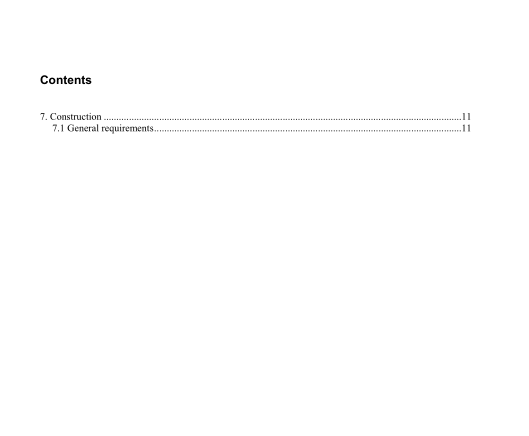IEEE C37.21a-2020 pdf download.IEEE Standard for Control Switchboards Amendment 1: Control and Secondary Circuits and Devices, and All Wiring
7.1.5.1 General All voltage circuits used for control, relaying, or metering shall be protected within the switchboard as follows:
a) All circuits supplied from external sources (ac or dc) shall have short-circuit protection. This may be provided by a single set of short-circuit protective devices within the control source incoming section.
b) All circuits supplied from internal sources (ac or dc) circuits shall have short-circuit protection within the same section as the supply source. If these circuits are supplied by a control power transformer, this protection may be in the primary circuit only.
c) Overcurrent protection of voltage circuits may be provided in addition to the required short-circuit protection.
d) Other circuits supplying loads, such as heaters, receptacles, and lights, shall have overload and short-circuit protection. Overcurrent protection of current transformer secondary circuits shall not be provided. Open circuit protection should be considered where current transformer wiring connects to devices external to the switchboard assembly. Primary and secondary protective devices may be omitted from voltage-dividing devices such as capacitive and resistive voltage dividers.
7.1.5.2 Voltage transformer fusing The following requirements shall be met:
a) Primary circuits of all voltage transformers shall include current-limiting fuses
b) Secondary circuits of all voltage transformers shall include fuses or their equivalent EXCEPTION: Fuses may be omitted from secondary circuits of voltage transformers if the secondary burden includes voltage regulators, protective relays, or other devices considered sufficiently essential to the operation of the installation to make it preferable to incur the hazards associated with the possible destruction of the voltage transformer by a sustained secondary short-circuit rather than to risk interruption of the voltage supply to such devices as a result of a momentary secondary short-circuit.
Replace 7.1.5.3 (formerly known as 7.1.5.1), including all subclause as shown: 7.1.5.3 Control, secondary, and logic level wiring Flame-retardant, 600 V insulated stranded copper wire shall be used for internal wiring between components of switchboard assemblies, and to terminals for connection to external controls, metering, or instrumentation.
Wiring within components is assumed to be covered by standards applicable to those devices and is not covered by this standard. Wiring for the purpose of conveying power to external switchgear loads is not covered by this clause.
Thermocouple wiring is specifically excluded from the above ampacity requirements. It shall meet the voltage, current, and temperature requirements of the circuit in which it is used and the location where it is installed. When required for connection to a specific component, low-energy signaling, and communication wiring is specifically excluded from the above ampacity requirements.
The wire shall meet the voltage, current, and temperature requirements of the circuit in which it is used and the location where it is installed.
NOTE—Where long connections to the control source are necessary, the cable must be large enough to prevent excessive voltage drop.
7.1.5.3.3 Wire protection and support
Bushings, grommets, or other mechanical protection shall be provided for wiring where it passes through a metal sheet, barrier, or raceway.
Wiring shall be adequately supported to prevent stress from causing damage of any kind to the conductors or the insulation. Wiring for circuits operating at different voltages shall be separated unless all wiring is insulated for the highest operating voltage of all the circuits intended to be bundled or closely grouped.
7.1.5.3.4 Wire type
Wiring shall be rated for 600 V, 90 °C, be flame-retardant, and shall meet the requirements of NEMA WC70 / ICEA S-95-658. Preferred wire is type SIS as listed in the NFPA 70 (NEC®) or an equivalent such as XHHW, RFHH-2, RFHH-3, or the like. Other wires which meet the requirements of this clause are also acceptable. Wiring used for connection directly on circuits above 600 V shall be rated for the voltage involved (or higher), 90 °C, and shall be flame-retardant.
In addition, wiring used for dc circuits for rated voltages of 48 V dc or above shall not contain PVC insulation. EXCEPTION: In addition, low-energy signal wiring may be used as required by the manufacturer of a specific component. This exception includes wiring such as the following:
Resistance Temperature Detectors (RTDs)
Low-energy signal communication cables (e.g. RS232, RS485, Ethernet, fiber optic, and similar networking cables)
Thermocouples
Coaxial cables
Ribbon cables
Shielded twisted-pair
Unshielded twisted-pair
Special consideration of such wiring should be given with respect to criteria in 7.1.5.3.1.
7.1.5.9 Voltage circuit protection
Replace text and lettered list in 7.1.5.9 (formerly known as 7.1.5.7) with the following text:
See 7.1.5.
7.1.5.10 Current transformer secondary circuit protection
Replace text in 7.1.5.10 (formerly known as 7.1.5.8) with the following text:
See 7.1.5.IEEE C37.21a pdf download.IEEE C37.21a-2020 pdf download
IEEE C37.21a-2020 pdf download

Leave a Reply